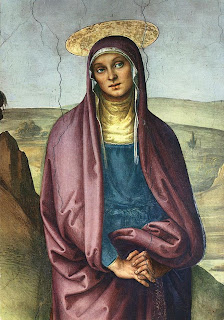Perugino, real name Pietro di Cristoforo Vannucci , was an Italian painter whose style is characterized by purity, simplicity, and exceptional symmetry of composition. Raphael, the greatest painter of the Umbrian school, was a pupil of Perugino.
Perugino was born in Città della Pieve, Umbria, and studied painting with the Florentine sculptor and painter Andrea del Verrocchio; he may also have worked with the Italian painter Piero della Francesca. Few of Perugino's early works have survived. One example, dated 1478, is a fresco, representing Saint Sebastian, in the Church of Castel Cerqueto near Perugia. By 1481 Perugino had been commissioned to paint a series of frescoes in the Sistine Chapel of the Vatican, which included his earliest extant major work, Christ Giving the Keys to Saint Peter. From 1486 to 1499, he lived in Florence, making a number of trips to Perugia, the city from which his name is derived, and to Rome. His works of this period include the Madonna with Saints and Angels (1493), now in the Louvre, Paris; and his celebrated Pietà (1495), in the Pitti Palace, Florence. Between 1499 and 1500 at Perugia he decorated the audience hall of the bankers' guild, the Cambio, with extensive frescoes depicting allegorical and sacred subjects. At about this time Raphael became one of his pupils. One of the best of Perugino's later works is an elaborate altarpiece painted between 1512 and 1517 for the Church of Sant'Agostino, Perugia. Among his other works are The Marriage of the Virgin (1503?-1504, Caen, France), which served as the model for Raphael's painting of the same subject; and Virgin between Saint Jerome and Saint Francis (1507, National Gallery, London). The fresco The Adoration of the Shepherds (1523, National Gallery) is thought to be his last work.

_1495.jpg)






















No comments:
Post a Comment